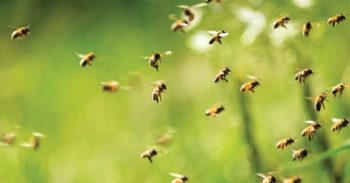
 Even though they’re very small, bees are very important to the food chain. Bees exist in climates all over the world from European forests to African deserts. They can even be found in the Arctic Circle, though Antarctica is the only continent without bees.
Even though they’re very small, bees are very important to the food chain. Bees exist in climates all over the world from European forests to African deserts. They can even be found in the Arctic Circle, though Antarctica is the only continent without bees.
Honey bees are part of a class of creatures referred to as “pollinators” because they help spread pollen, which is essential for crops. About 75 percent of crops, including apples, peaches, cucumbers, almonds, etc., rely on pollination from an outside source like honey bees, bats, butterflies, hummingbirds, flies and other species of bees.
Are Bees Endangered or Threatened?
Technically, honey bees are not on the endangered species list, but other types of bees are, and honey bee populations have dropped, causing concern. For that matter, the populations of a variety of bee species have been decreasing on a global level. Worse, it seems to be happening for a variety of reasons including habitat destruction, climate change, disease, and mites, to name a few. An award-winning documentary, The Pollinators, addresses the complexity of the problem and its ramifications.
The U.S. Fish and Wildlife Service added seven species of Hawaiian yellow-faced bees to the endangered species list in 2016. In 2017, the rusty patch bumble bee joined them on the list. In addition to those eight species, on a global level the International Union for Conservation of Nature (IUCN) listed 16 bee species as vulnerable, 18 as endangered and 9 as critically endangered.
Conservation groups are also pushing to have four species of bees native to California added to that state’s list of endangered animals. The problem in California is so bad that they have to bring in millions and millions of bees from other states to pollinate the state’s almond crops.
Even if a given bee species doesn’t qualify for the endangered species list, they still might have shrinking numbers. The U.S. Department of Agriculture first began tracking honey bee hives in 1947. At that time there were 5.9 million colonies. That number dropped to 2.44 million in 2008. Since then honey bee colonies have risen slightly to 2.67 million but it’s too soon to tell if that’s a temporary increase or a sign of recovery. With drops in population for other types of bees and other species of pollinators, experts warn that it’s too soon to relax.
Do honey bees bite?
No, honey bees do not bite. In fact, unlike wasps, yellow jackets or hornets, honey bees are not aggressive at all. They only sting to protect the colony.
That said, a honey bee nest too close to a house, business, etc. can be disconcerting – especially if you’re allergic to bees. In light of the value and benefits of honey bees to our ecosystem, however, and the decline in their overall population, Arrow Exterminating does not remove honey bee colonies and strongly advises having a professional bee keeper move the colony to a new location. Arrow recommends Long Island Bee Keepers.
Arrow Are the Bee Experts
If any bee species have formed a colony on your property, call Arrow Exterminating to identify the type of bee and provide the right solution. To get started, contact Arrow Exterminating today.




